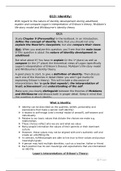Q13: Identity:
With regard to the nature of identity development during adulthood,
explain and compare Logan’s interpretation of Erikson’s theory, McAdam’s
life-story model and Whitbourne’s identity theory
Q13:
Study Chapter 9 (Personality) in the textbook. In an introduction,
define the concept of identity. Note that you should not only
explain the theorist’s viewpoints, but also compare their views.
Hint: When you analyse this question, you’ll see that the main issue
in this question is about the nature of identity development in
adulthood.
But what about it? You have to explain (in the 1st place) as well as
compare (in the 2nd place) the theoretical views of Logan (specifically
Logan’s interpretation of Erikson’s theory); McAdam’s life-story model
and Whitbourne’s identity theory.
A good place to start, to give a definition of identity. Then discuss
each one of the theories in detail (Note: you won’t get marks for
explaining Erikson’s theory). This will include a discussion of
interpretations like ‘a cycle that repeats’; the interpretation of
trust; achievement and understanding of the self.
Make sure you clearly distinguish between the theories of McAdams
and Whitbourne and discuss both in proper detail. Keep in mind that
this question is about identity.
What is Identity:
Identity can be described as the qualities, beliefs, personality and
expressions that make a person (self-identity)
It relates to self-image (one’s mental model of oneself), self-esteem and
individuality
Relates to our basic values that dictate the choices we make e.g.
relationships
These choices reflect who we are and what we value
Many people internalize the values of their parents or their dominant
culture
However, these values may not be aligned with one’s authentic self and
create an unfulfilling life
In contrast, fulfilled people are able to live true to their values and pursue
meaningful goals
A person may hold multiple identities, such as a teacher, father or friend
Each position has its own meanings and expectations that are internalized
as identity
Logan’s Interpretations of Erikson’s Theory:
1|Page





